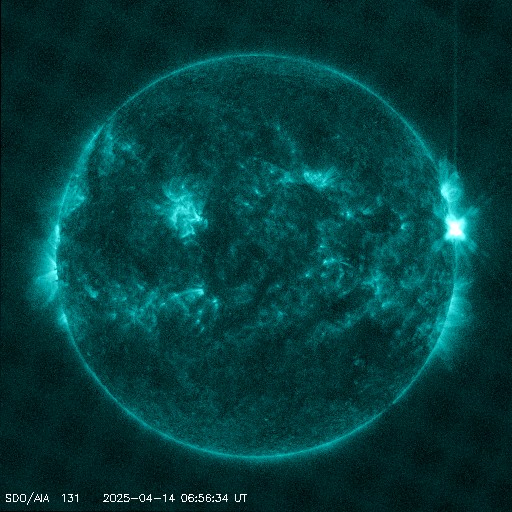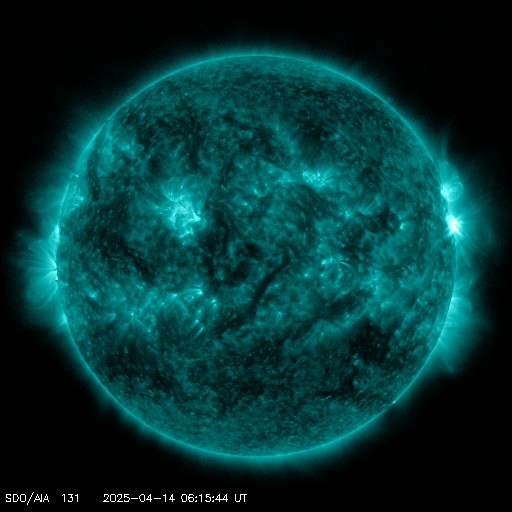Viewing archive of Friday, 31 August 2001
Solar activity report
Any mentioned solar flare in this report has a scaling factor applied by the Space Weather Prediction Center (SWPC). Because of the SWPC scaling factor, solar flares are reported as 42% smaller than for the science quality data. The scaling factor has been removed from our archived solar flare data to reflect the true physical units.
Report of Solar-Geophysical Activity 2001 Aug 31 2200 UTCPrepared by the NOAA © SWPC and processed by SpaceWeatherLive.com
Joint USAF/NOAA Report of Solar and Geophysical Activity
SDF Number 243 Issued at 2200Z on 31 Aug 2001IA. Analysis of Solar Active Regions and Activity from 30-2100Z to 31-2100Z
Solar activity was moderate due to a single M-class
event during the period. Region 9601 (N14E32) produced an M1/Sn
event with an accompanying 270 sfu Tenflare and a Type II radio
sweep (velocity est. 961 km/s). LASCO imagery does not show any
signs of an earth-directed coronal mass ejection from this event.
Region 9601 has continued to show growth over the period and is
capable of producing a major flare at any time. Region 9591 (S20W39)
has shown some signs of minor decay during the period. It continues
to retain a beta-gamma-delta magnetic configuration and is still
capable of producing an isolated major flare before it rotates over
the western limb on September 04-05. There are only three other
spotted regions on the disk at this time. None of which have
produced any significant activity.
IB. Solar Activity Forecast
Solar activity is expected to be
moderate to high. Region 9591 and 9601 are expected to continue to
produce isolated M-class events and both are capable of producing a
major flare during the forecast period.
IIA. Geophysical Activity Summary 30-2100Z to 31-2100Z
The geomagnetic field was mostly quiet to unsettled with isolated
active periods.
IIB. Geophysical Activity Forecast
The geomagnetic field is
expected to be quiet to active with recurrent coronal hole effects
beginning on 01 September. Barring any earth-directed coronal mass
ejections, conditions should return to mostly quiet to unsettled on
03 September.
III. Event Probabilities 01 Sep to 03 Sep
| Class M | 80% | 80% | 80% |
| Class X | 25% | 25% | 25% |
| Proton | 25% | 25% | 25% |
| PCAF | yellow | ||
IV. Penticton 10.7 cm Flux
Observed 31 Aug 189 Predicted 01 Sep-03 Sep 190/190/190 90 Day Mean 31 Aug 156
V. Geomagnetic A Indices
Observed Afr/Ap 30 Aug 008/013 Estimated Afr/Ap 31 Aug 015/015 Predicted Afr/Ap 01 Sep-03 Sep 015/015-015/025-012/020
VI. Geomagnetic Activity Probabilities 01 Sep to 03 Sep
| A. Middle Latitudes | |||
|---|---|---|---|
| Active | 25% | 25% | 20% |
| Minor storm | 10% | 10% | 05% |
| Major-severe storm | 01% | 01% | 01% |
| B. High Latitudes | |||
|---|---|---|---|
| Active | 30% | 30% | 25% |
| Minor storm | 15% | 15% | 10% |
| Major-severe storm | 01% | 01% | 01% |
All times in UTC
Current data suggests there is a slight possibility for aurora to appear at the following high latitude regions in the near future
Gillam, MB, Whitehorse, YT, Yellowknife, NTLatest news
Latest forum messages
2025/04/12-13 Filament CMEs 2025/04/16 G2 Watch 51Ask your obscure/"stupid" space weather questions. 352Filaments and prominences 62Incoming & Unnumbered Active Regions 1708AR 4055 99
More topicsSupport SpaceWeatherLive.com!
A lot of people come to SpaceWeatherLive to follow the Sun's activity or if there is aurora to be seen, but with more traffic comes higher server costs. Consider a donation if you enjoy SpaceWeatherLive so we can keep the website online!

Latest alerts
Monday, 14 April 2025
23:15 UTC - Geomagnetic activity
Active geomagnetic conditions (Kp4) Threshold Reached: 23:01 UTC
07:09 UTC - Solar flare
Moderate M4.28 flare from sunspot region 4055
06:48 UTC - Radio Blackout
Minor R1 radio blackout in progress (≥M1 - current: M1.53)
06:24 UTC - Solar flare
Moderate M1.49 flare from sunspot region 4055
06:06 UTC - Radio Blackout
Minor R1 radio blackout in progress (≥M1 - current: M1.16)
Space weather facts
| Last X-flare | 2025/03/28 | X1.1 |
| Last M-flare | 2025/04/14 | M4.2 |
| Last geomagnetic storm | 2025/04/06 | Kp5 (G1) |
| Spotless days | |
|---|---|
| Last spotless day | 2022/06/08 |
| Monthly mean Sunspot Number | |
|---|---|
| March 2025 | 134.2 -20.4 |
| April 2025 | 128.8 -5.4 |
| Last 30 days | 129.1 -15.1 |





